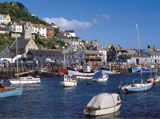The proposed marine graywater filter system is a multi-stage process. The first stage involves elimination of coarse pollution and large particles, while at the same time subsequent filtration stages are protected from blockage. In the second stage, grease is eliminated by a special filter. This filter was designed for the elimination of oil and separation of grease from bilge water (water collected in the bilge of the boat and often contaminated with engine oil) and has been used effectively for many years. The third, and, where necessary, a fourth, stage involves the elimination of soluble nutrients. The filter media are configured into cartridges or filter bags and can be exchanged easily after use and disposed of on shore.
First, we searched for filtration medium suitable for eliminating soluble nutrients (carbon, nitrogen and phosphorous compounds) from graywater. For this purpose a pilot plant was operated with synthetic graywater and different filter media were screened.
In the screening process, the aim is to make findings quickly while under realistic circumstances. Therefore, filter media were tested configured into cartridges and high filtration velocity was chosen. Comparable and significant results could be derived within 60 minutes. As an example, the chart shows the results of a screening for the removal of carbon compounds, measured as chemical oxygen demand (COD). We were able to demonstrate that with the best filter material configuration loading – and thus COD elimination - could be achieved two to three times higher than with conventional filter cartridges within the same time and at the same capacity (see GWF04 in the chart).
The removal of particulate and colloidal material by the filtration system was tested with real graywater from showers and washing machines. For this purpose, the best-performing filter media from the screening were used in order to identify in turn the best filter media and filtration system configuration. Preference was given to a specially configured activated carbon filter that can be combined with an ion exchange resin.
 Fraunhofer Institute for Interfacial Engineering and Biotechnology IGB
Fraunhofer Institute for Interfacial Engineering and Biotechnology IGB